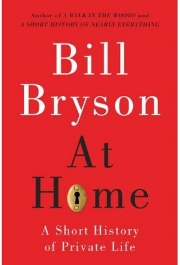
At Home: A Short History of Private Life
by Bill Bryson
–Reviewed by Christine C. Chen
 One could judge Bill Bryson’s latest tome by the author photo. At Home: A Short History of Private Life is as amiable and comfortably tweedy as the Bryson himself. Those familiar with his other works, such as A Short History of Nearly Everything and Made in America, will not be disappointed by the rambling, often surprising, and unpretentious display of erudition that is Bryson’s calling card.
One could judge Bill Bryson’s latest tome by the author photo. At Home: A Short History of Private Life is as amiable and comfortably tweedy as the Bryson himself. Those familiar with his other works, such as A Short History of Nearly Everything and Made in America, will not be disappointed by the rambling, often surprising, and unpretentious display of erudition that is Bryson’s calling card.
Starting with the simple premise of spelunking within the walls of his own home, a quaint Victorian-era parsonage, Bryson uses the rooms and spaces of the house – beginning with the hall and ending with the attic – as touchstones for a wide-ranging inquiry into the historical forces and personalities that shaped the transition from medieval to modern life in England and America.
As he sets out in his introduction, Bryson intended that “the bathroom would be a history of hygiene, the kitchen of cooking, the bedroom of sex and death and sleeping, and so on.” In short, he “would write a history of the world without leaving home.” Thus the book begins with a blueprint of the author’s house and ends 452 pages later having covered large swaths of history. We learn that huge portions of fat-laden food, far from being a modern American habit, were typical at 18th-century aristocratic tables. (It seems that, contrary to painterly depictions, Queen Anne was less Rubenesque than “exceedingly gross and corpulent.” She eventually attained such girth that she had to be hoisted up and down the floors of Windsor Castle by pulley because she could not fit in the staircases.) We also learn that women used to spackle their faces with a poisonous “foundation” of white lead ground into paste, and why furniture is called meuble in French and mobilia in Italian – medieval furniture was designed to be highly mobile so it could be carried from estate to estate. As for why the Victorians were so squeamish about bodies and sex, the answer can be found in much greater, and amusing, detail.
If there is one continuous thread running throughout this encyclopedic exploration of private life and its consequences, it is that, perhaps, across time and across oceans, people remain much the same. Whether living in dwellings made of earth or castles made of stone, people have always been driven by the same impulses in building their homes – either to protect themselves from a world that threatens to intrude, or to create their own worlds within, of comfort and luxury. So, too, do the aforementioned examples of gluttony and vanity reveal essential truths about us. Medieval and early modern practices might seem cruel and bizarre, but they do seem to bare an unflattering resemblance to our own current state of affairs. And we can’t forget that the material stuff that makes up our lives still indicates what we value – or what we don’t value.
And we cannot forget that the material “stuff” that comprises our lives can be indicative of what we value – or more grimly, in terms of human rights, do not value – in a society. The breathtaking number of technological advances in the 19th century would have, as Bryson notes, huge ramifications for private life, “socially, intellectually, technologically, hygienically, sartorially, sexually.” Bryson evocatively describes the dizzying pace of progress in terms of his home’s original occupant, the Reverend Marsham: “Mr. Marsham was born (1822) into a world that was still essentially medieval – a place of candlelight, medicinal leeches, travel at walking pace, news from afar that was always weeks or months old – and lived to see the introduction of one marvel after another: steamships and speeding trains, telegraphy, photography, anesthesia, indoor plumbing, gas lighting, antisepsis in medicine, refrigeration, telephones, electric lights….”
Were he to be magically transplanted from 1860 to the technologically driven world of today, Bryson’s good Reverend might have gone running for refuge in the nearest parish church. Automated and wired “smart homes” or “homes of the future,” once only imagined in science fiction, are now very much a product of the present. If home is where the heart is, then this book suggests that it is also where the world enters and resides.
Buy the Book: Skylight, Powell’s, Amazon, Borders
Further Reading: A Short History of Nearly Everything by Bill Bryson and Home: A Short History of an Idea
by Witold Rybczynski
Christine C. Chen teaches humanities at St. John’s College in Santa Fe, New Mexico and is also a professional violinist.
*Photo courtesy Venturist.




Send A Letter To the Editors